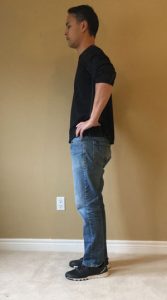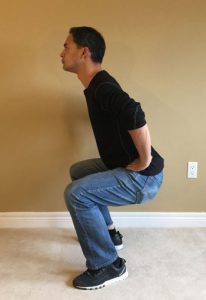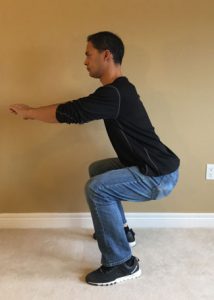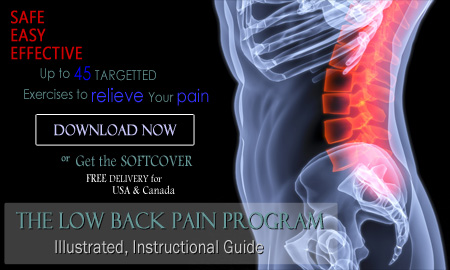The Squat Hold Test for Back Pain
Hold a Squat Position to know your risk for back problems

SN Health Resources | Updated Dec 14, 2020
Squatting is essential for keeping your lower back stable and neutral.
It is a preventative movement, so it helps you remain upright whenever you need to change your posture and height.
Most of the time that we squat is when we need to sit. But you actually need to do it a lot more than you think.
In fact, if you are suffering from lower back problems right now, you will find it very uncomfortable to hold a stationary squat position. This is a key indication that your hips are in need of serious retraining and reconditioning. Fortunately, you are at the right website!
You should be relying on squatting instead, whenever you choose to lean forward or bend down.
Do you remember that time when you had a brutal back spasm and you couldn’t use your back muscles at all? What did you have to do to get around? That’s right. You used your arms & leg squatting skills big time to protect you.
The number of times that you should squat happens more often than you would think. Perhaps several dozens of times every day. If you are not squatting enough, your spine and muscles are being forced to take the strain and will fatigue from the movements. Eventually, it will tire from all of the extra work.
The Squat Hold Test
1) Start from a standing position with your feet shoulder width apart

2) Slowly lower yourself down until your thighs are just above parallel to the floor

3) Hold this position for at least 15 seconds minimum

Modified squat with arms extended
4) Raise up to a standing position
How Did You Do?
How did it feel to lower and hold?
Did you have any strain in your thigh muscles? Did they tire?
Was there any stiffness or tightness in the hips as you moved downward?
Did you feel any discomfort (sharp pain) from your knees? Especially your knee caps?
Was there any soreness or fatigue with your joints or muscles?
Was it difficult maintaining balance without any support?
Did it feel like your bum was tucking in instead of sticking out behind?
If you answered yes to any of these questions, you are at risk.
For only 15 seconds, you are supposed to be able to HOLD the Squat without any strain. 15 seconds is considered a very short time. Most people should be able to hold this squat without discomfort for up to 5 minutes at a time.
If this simple posture was difficult, it’s because of the following:
- Tight hamstrings are tucking in your bum
- Short calf muscles are throwing off your balance
- Weak gluteus major is fatiguing and causing your quads (thighs) to also fatigue
- Overused quads are straining your knees and kneecaps
- Poorly functioning glutes are over controlling your hips
- Poor hip flexors are limiting your pelvic stability
- Weak abs are affecting your core which affects your neutral curve
All of this can be revealed just from this one simple squat test.
The better your ability to squat, the healthier your spine, joints and muscles will be.
Part of the reason that people don’t like to squat comes from: burning thighs (fatigue), knee pain, butt pain, or simply that it feels unnatural (probably from all of the discomfort). But the more you do it, the better it gets!
Don’t let this discourage you because it can be fixed. You only need more practice, dedication, and to rely on squatting as your preferred way to lower your body
The most difficult part of reconditioning your leg muscles has really to do with overcoming the discomfort of retraining and developing stronger muscle tissue. Although it can feel like forever to do it, it’s necessary for your lumbar stability. The end result is less pain.
The next test is another simple test to determine whether or not your hips are doing their job to support your lower back.
Go to Test #3
The Hip Raise Test
Note: This test will reveal if you have developed stiff and weak glute muscles. When they become too weak, they stop supporting you and your back strains.
For more help:
Take the previous test: The Standing Leg Raise
Take the next test: The Hip Raise
Test your gluteus and hip strength

